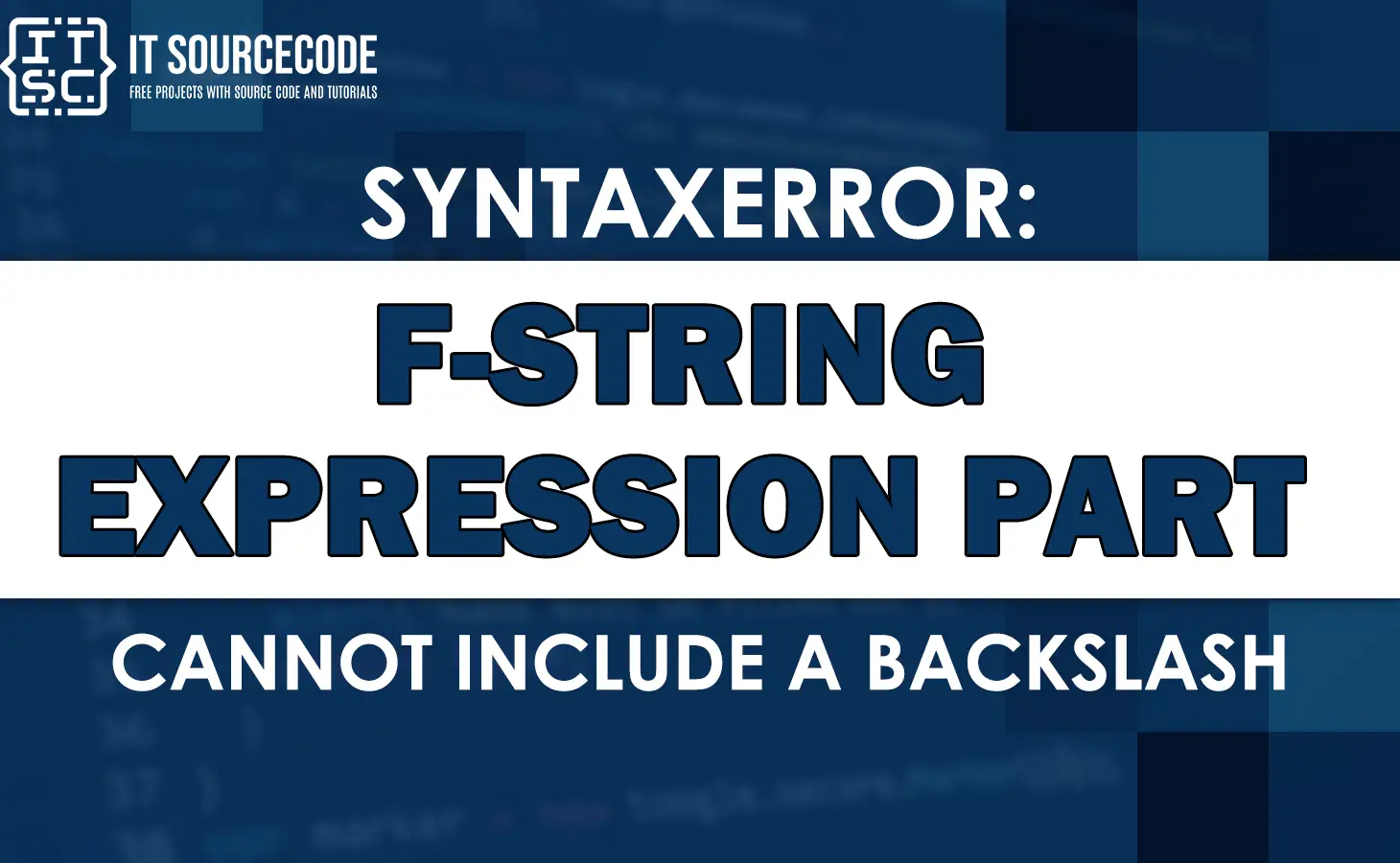The syntaxerror: f-string expression part cannot include a backslash is an error message happens while we are using the f-string format in Python.
If this error gives you a hard time, keep reading because we’ll help you resolve this error.
In this article, we’ll walk you through how to fix the f-string expression part cannot include a backslash, a SyntaxError in Python.
What is “syntaxerror f-string expression part cannot include a backslash”?
The error message syntaxerror: f-string expression part cannot include a backslash occurs when you are trying to use a backslash character within the curly brackets in the f-string in Python.
For example:
f_name = 'It'
l_name = 'sourcecode'
result = f'{f_name\n}{l_name}'
Output:
File "C:\Users\pies-pc2\PycharmProjects\pythonProject\main.py", line 4
result = f'{f_name\n}{l_name}'
^
SyntaxError: f-string expression part cannot include a backslash
This error is raised because the escape character is included inside the curly brackets, which is the expression part of the f-string format.
Note: It is impossible to include backslashes in curly braces {} of f-strings when you are working with Python.
Why does the “f-string expression part cannot include a backslash” SyntaxError occur?
The syntaxerror: f string expression part cannot include a backslash error message occurs because you used the backslash between the curly braces of the formatted string.
This is currently a limitation of f-strings in python. Backslashes aren’t allowed in them at all.
F-strings use curly braces {} as placeholders and the backslash (\) character conflicts with this syntax.
When the interpreter encounters a backslash inside an f-string expression, it assumes that you want to escape the following character, which leads to SyntaxError.
How to fix the “syntaxerror: f-string expression part cannot include a backslash”?
To fix the syntaxerror: the f-string expression part cannot include a backslash error. You have to store the backslash character in a variable and move it out or place the escape character outside of the curly braces.
Solution 1: Relocate the backslash outside of the curly braces
When you don’t have an expression to include and you only have a backslash or a \n character, simply put it outside of the curly braces.
For example:
f_name = 'It'
l_name = 'sourcecode'
print(f"{f_name}\n{l_name}")
Output:
It sourcecodeAs you can see, there’s no errors occur.
In case you really need to include escape characters like “\t” or “\n” in an f-string format, remember to place the character outside the curly braces.
But if you really need to have the characters inside the curly braces, you should use a variable to accomplish that.
For example:
familiesname = ['Anna', 'Liza', 'Carla', 'Denise', 'Anthony']
newline = '\n'
sample_str = f'Family list: \n{newline.join(familiesname)}'
print(sample_str)
As you can see, the above example illustrates how to store a newline character in a variable. This way, we can easily use it within the expression of an f-string.
Output:
Family list:
Anna
Liza
Carla
Denise
AnthonyAs you can observe, using a variable is a simple and convenient way to work around the limitation of f-strings.
Let me show you an example of how to include the tab \t character using a variable:
f_name = 'It'
l_name = 'sourcecode'
tab = '\t'
print(f"{f_name}\t{l_name}")Output:
It sourcecode
Another example:
f_name = 'It'
l_name = 'sourcecode'
backslash = "\\"
print(f"{f_name + backslash + l_name}")Output:
It\sourcecodeSolution 2: Instead of using formatted string literal use Use str.format() method
An alternative approach to using a formatted string literal is to utilize the str.format() method.
For example:
f_name = 'It'
l_name = 'sourcecode'
result = "Name: {} {}".format(f_name, l_name)
print(result)Output:
Name: It sourcecodeSolution 3: Use os.linesep()
When you want to add a newline character to a string, an alternative option is to utilize the os.linesep attribute instead of using \n.
For example:
import os
sample_str = f"It{os.linesep}sourcecode"
print(sample_str)
Output:
It
sourcecodeConclusion
In conclusion, the error message syntaxerror: f-string expression part cannot include a backslash occurs when you are trying to use a backslash character within the curly brackets in the f-string in Python.
To fix this error, you have to store the backslash character in a variable and move it out or place the escape character outside of the curly braces.
This article already discussed what this error is all about and multiple ways to resolve this error.
By executing the solutions above, you can master this SyntaxError with the help of this guide.
You could also check out other SyntaxError articles that may help you in the future if you encounter them.
- Syntaxerror: cannot assign to literal here in Python
- Syntaxerror eof while scanning triple-quoted string literal
- Syntaxerror can’t assign to function call here
We are hoping that this article helps you fix the error. Thank you for reading itsourcecoders 😊

